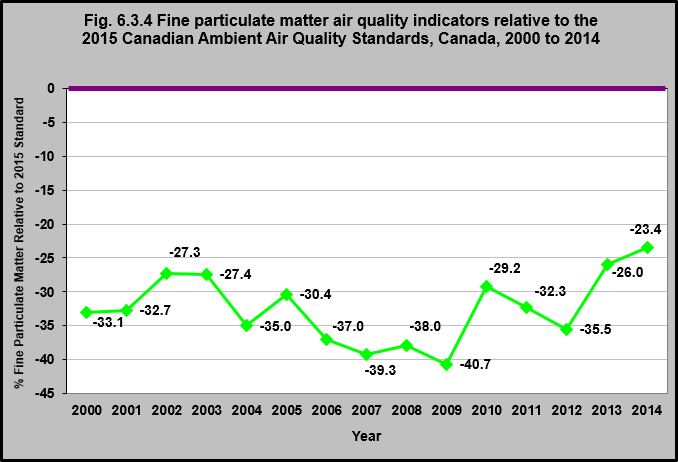Fine particulate matter air quality indicators relative to the 2015 Canadian Ambient Air Quality Standards, Canada, 2000 to 2014

Note:
New fine particulate matter monitoring equipment was progressively introduced across Canada to replace older monitoring equipment from the mid-2000’s to 2014. These new instruments measure a portion (semi-volatile) of the fine particulate matter mass not captured by the older instruments. Due to the differences between the new and the old monitoring equipment, concentrations measured with the new monitors may not be directly comparable with measurements from years in which older instruments were used.
Source: CICH graphic created using data adapted from Environment and Climate Change Canada. 2016. Canadian Environmental Sustainability Indicators: Air Quality. https://www.ec.gc.ca/indicateurs-indicators/7DCC2250-A982-4286-B466-70681EBC994B/AirQuality_EN.pdf – accessed March 12th, 2017
A number of pollutants can cause poor air quality – ground-level ozone (O3), sulphur oxides (SOX), nitrogen oxides (NOX), volatile organic compounds (VOCs) and solid and liquid particles called fine particulate matter (PM2.5).1
Smog is primarily made up of ground-level ozone (O3) and fine particulate matter (PM2.5). These pollutants can cause adverse health and environmental effects.1
The annual average PM2.5 is an indicator of air quality. It is based on the annual average of the daily 24-hour average concentrations for PM2.5 and is used to capture prolonged or repeated exposures over longer periods or chronic exposure.1
Between the years 2000 and 2014 the annual average PM2.5 was below the 2015 national air quality standards. In 2014, it was 23% below the 2015 standard.
Implications
Exposure to fine particulate matter has been associated with asthma, bronchitis and emphysema as well as heart disease.1
1Environment and Climate Change Canada. 2016. Canadian Environmental Sustainability Indicators: Air Quality. https://www.ec.gc.ca/indicateurs-indicators/7DCC2250-A982-4286-B466-70681EBC994B/AirQuality_EN.pdf – accessed March 12th, 2017.
